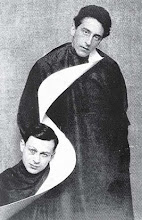"Chairman Mao Inspects
the Cultural Revolution in Various Location," is shown in a Chinese
papercut recently discovered at the Center for Chinese Studies at the
university during a cleaning of a storage room. The papercuts portray
the euphoria and zeal of the era as well as the violence and destruction
that left the Chinese economy in shambles.
By: Jeff Karoub, Associated Press
ANN ARBOR (AP).- Propaganda pieces produced in China four decades
ago during the Cultural Revolution have been unearthed in a storage
room at the University of Michigan — a rare find in either the U.S. or
its country of origin, experts said.
The rediscovery of the 15 poster-sized papercut images illustrating
the political upheaval of the era is a pleasant surprise to scholars
studying a society that was largely closed off from the West. The images
are cut out of red paper in the same way that artists customarily
create decorations for Chinese New Year celebrations and other
festivities. They include glowing portrayals of late Chinese leader Mao
Zedong and Red Guards burning books and trampling on a Buddhist statue.
Eliminating the Four Olds
The handmade images were stored at the university's Center for
Chinese Studies, which is celebrating its 50th anniversary. Carol
Stepanchuk, the center's community outreach coordinator, found them
while sorting through boxes in its storage room. She said the collection
of 15 framed images "stood out." The frames weren't in great shape, but
the images were in "remarkably good condition," she said.
Support the Army and Cherish the People
Stepanchuk took them to her office and brought the find to the
attention of faculty members, who marveled at the rarity and quality of
an entire set that tells a coherent story.
The late scholar Michel Oksenberg, who taught at the university for
two decades, collected the papercuts while doing research in Hong Kong
in the early 1970s and donated them to the center when he left in 1991
to lead the East-West Center in Honolulu.
Rallying workers threatening to stab political enemies with giant fountain pens that look like spears.
Ena Schlorff, the center's program coordinator, remembered the donation.
"We were storing them for future consideration," said Schlorff, who
had been Oksenberg's personal secretary. "It took the newer faculty ...
to realize the current importance of this collection."
"Long live the Great
Proletarian Cultural Revolution!" says the slogan on the flag that
features the profile of the late Chinese leader Mao Zedong.
Associate history professor Wang Zheng said the collection was
produced at a small, folk art institute in the southern province of
Guangdong, and it most likely wasn't commissioned by Communist Party
leaders. She said it shows how young artists at the time understood and
related to the decade-long Cultural Revolution, and she plans to use one
of the images in a book she is writing.
"They did not have embedded interests in the establishment, and the
Cultural Revolution was to smash the establishment," Zheng said. "The
young ones who didn't have power ... likely identified with it."
The papercut celebrates the
nation's first Marxist big character poster, one of the most popular propaganda
tools in the Cultural Revolution. The image also praises editorial staff at the
People's daily, the mouthpiece of the Communist Party, for writing about the
poster.
Zheng said it's rare for the English-speaking world to have access
to such visual historical documents. Even in China, she said, this
collection probably would not have survived because it features Mao
alongside Lin Biao, who was accused of plotting a coup against Mao and
deemed a traitor. He died in a plane crash while flying to the Soviet
Union in 1971.
"This whole project would be politically incorrect," she said.
Xiabong Tang, a professor of Chinese literature and visual culture,
said in a university release that the images are more valuable than
others found online because of their complexity and detail. He estimated
that each papercut could be worth more than $150 to a serious
collector.
The university has no immediate plans for a public display of the
actual papercuts but has digitized the images and posted them online.
NOTE: A fascinating story about a remarkable discovery, which will come as a not-so-great surprise to anyone who has ever spelunked around museum or library inventory spaces or cleaned out an attic. Things turn up. The World Turns. One day you're "world-beating" China, wreaking havoc, spinning death-webs and having tea with Nixon and Kissinger; the next you're boxed and forgotten detritus. The formal excellence and beauty of these images reminds me of the strange relationships between intelligence, knowledge, talent, common sense, ignorance, promise, politics, good, evil and justice. Funny, confusing old world. Mao's last "fan" (he even eventually lost Albania) seems to be that dreadful former White House communications director, Anita Dunn, who improably paired his philosophy as a moral polestar with that of Mother Teresa. Funny, sad old world where popular comedy's Olympus now is the unfunny, predictable and tepid sarcasm of Stephen Colbert and Jon "Grimace At Everything" Stewart.
A link to the University of Michigan website containing the complete collection of images (high res scans) and information is found HERE.









No comments:
Post a Comment